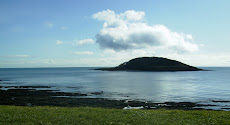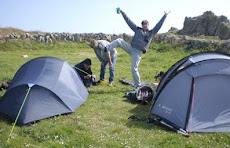It was Daddy-Daughter day today. Now I face the age old thorny issue - how do you combine spending "quality time" with, in my case, 16 month old daughter, and take in a wee spot of birding? Well, here's an idea - start a playground / play park list. Mine has already got Black Redstart on it (Seaton, January this year). You'll be amazed how many decent birding sites have some conveniently placed swings or slides in close proximity. Most reservoirs offer something, but the best are those where an attentive father (or indeed mother) can entertain offspring while keeping ears open for grounded migrants. There's one in Baltimore a stones throw from where the boat to Cape Clear leaves, which has a number of sheltered sycamores and shrubs that are crying out for a crippler (and that's not what happens when daddy gets too distracted by the skulking phyllosc and little one takes a nose dive off the slide). There's also one on the Garrison on St Mary's complete with pirate ship. However, I would suggest that care needs to be taken when combining parenting in such a fashion and birding, as the presence of your standard birder in the midst of a play park may cause alarm. I have some tips:
1) Only take bins if you are sure the coast is clear. Now think of this as being highly instructive as you'll have to rely on fieldcraft, eyes and ears - this is quite liberating (although I know would bring your average twitcherer out in a cold sweat - but you really aren't going to get away with wandering around the swings with your tripod fully extended, try it - the legs do actually retract you know)
2) Try and dress down (you know - like a normal person). There's no need to wear full birdy greens and it might actually stop you looking like such an arse, especially if you are one of those people that seem to have to dress in full twitcherer regalia at the bird fair while browsing through the holiday brochures - although I can see why you'd want to blend in with the surrounding countryside while stood in a marquee talking loudly to other similarly clad folk about the last twitch you went on).
Take these two tips on board and you are assured a trouble free bit of playground birdspotting.
Anyway, Siblyback coincidentally has just such a playground. No decision to make. The Smew was still there, and being watched by another birder. Now is it just me or does everybody get a teeny weeny bit narked when another birder invades their patch. Those who adopt patches that actually have decent birds regularly probably get used to it, but for someone who goes out of their way to find one that will attract decent birds so rarely that they will never have to cross paths with another spotter, it is different. And to make it worse, said imposter announces that oh yes, it's been around a month and was originally seen on Siblyback before moving to Dozmary. What the.....Welcome to Cornwall birding. Now I know I don't spend all my days with one hand on a pager (sorry that dates me - it's all texting now I believe) but I do keep an eye on what's around locally. Oh well.
Supporting cast was a female Goosander, Kingfisher, still 43 Coot, and a staggering 5 Tufted Duck. It was a bonny morning though with a smattering of snow but clear skies and whisps of mist, and in response to the sunshine the first few hints of springtime sound - a few Siskins in the pines, Goldfinches chattering and a Mistle Thrush singing.
Later headed down to Hannafore, 6 Med Gulls, 1 Eider, 1 Grey Plover and a Ringed Plover the only things of note.
 op of the range kit still doesn't make it any easier to identify a stick carrying bird, there is an alternative pursuit. Check out http://www.youtube.com/watch?v=cwvVh0_ZelI. This is absolutely hilarious and I think would also add a bit of spice to the annual birders vs locals footy match on the Scillys.
op of the range kit still doesn't make it any easier to identify a stick carrying bird, there is an alternative pursuit. Check out http://www.youtube.com/watch?v=cwvVh0_ZelI. This is absolutely hilarious and I think would also add a bit of spice to the annual birders vs locals footy match on the Scillys. 




















